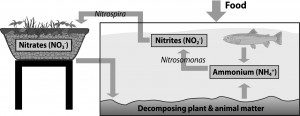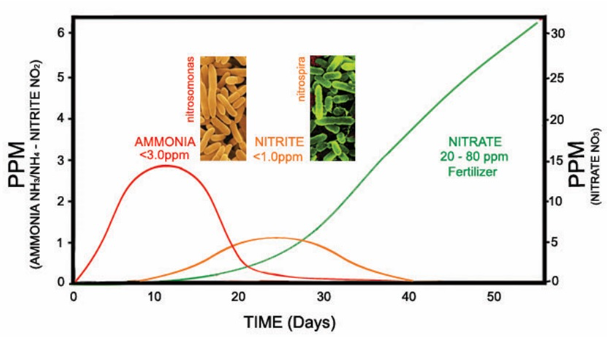Nitrogen cycling happens in soil and water all around the earth.  Aquaponics cycling is the natural process of bacteria oxidizing ammonia into nitrates.
Aquaponics cycling is the natural process of bacteria oxidizing ammonia into nitrates.
The Nitrification “Cycling” Process
The cycling process starts when ammonia is present in your aquaponic system. Ammonia (chemical formula NH3) is a compound made of nitrogen and hydrogen. Fish produce ammonia most from their feces, urine, and respiration through their gills. Just as our own waste is toxic to us, ammonia is toxic to fish and can kill them. The cycling process converts ammonia to a less toxic form of nitrogen (nitrate) that plants can readily digest.
Ammonia attracts nitrosomonas, the first of the two types of nitrifying bacteria that will populate on surfaces and in your system’s biofilter. The nitrosomonas bacteria convert the ammonia into nitrites (NO2). This is the first step in the aquaponics cycling process. Unfortunately, nitrites are even more toxic than ammonia! But the cycling process does not stop there. Presence of nitrites will attract the bacteria species nitrobacter. Nitrobacter converts the nitrites into nitrates. Nitrates are generally harmless to the fish and an essential nutrient for your plants.
Cycling Startup

Cycling starts when first setting up or restarting an aquaponic system. The cycling process generally takes from 4-6 weeks. The time frame is dependent on the water temperature (ideally 75° – 80° F or 24° to 26° C). Water temperatures outside this range will take longer to cycle since the bacteria will be slower to eat and reproduce. Once cycling is complete, water temperatures should be between 70° to 75° F, 21° to 24° C). This is a temperature range that is good for both fish and plants.
You can speed up the cycling process by introducing nitrifying bacteria instead of waiting for them to appear on their own. Add a bacteria supplement to the media surface or water, so they can populate your aquaponic system faster.
Cycling with Fish
- Start fish cycling by adding a few hardy fish to the tank like Goldfish, Tilapia or inexpensive Koi for example. The fish will provide the ammonia source. Do not feed the fish for the first 24 hours. Only lightly feed for the first several days and only what they are willing to consume. Excess feed should always be removed from the tank.
- Add a nitrifying bacteria starter such as Nite-Out or let the bacteria populate naturally.
- Perform and record water tests every day to check ammonia, nitrite, and nitrate levels. Ammonia should remain below 3.0 ppm. Nitrites should remain below 1.0 ppm. Nitrates will increase over time.
- Exchange 1/3 of the tank water if ammonia gets above 3.0 ppm, or nitrites above 1.0ppm. Fish can suffer and may die if levels get higher than these.
Fishless Cycling
Cycling with fish can be stressful (on both you and the fish). An alternative is fishless cycling.
- Add a bacteria starter or let the bacteria arrive naturally.
- Add a supply of pure ammonia (powder or liquid) until levels are between 2 to 4.0 ppm.
- Perform water tests daily to detect ammonia, nitrite and nitrate levels.
- Continue to add ammonia to keep the ammonia levels between 2 to 4.o ppm.
- Cycling is complete when ammonia and nitrite levels drop below 0.5 ppm with 24 hours. The presence of nitrates indicates cycling is taking place.
- Stop dosing the system with ammonia and add your fish into the system. Do not feed for the first 24 hours.
Optimizing Cycling
- Cycling will happen quickest when water temperatures are between 74 and 80°F (23-26°C). Any water temperature below 64°F (18°C) will slow bacterial growth rates by 50% or more. After cycling, slowly allow the temperatures to drop into the 70o – 74o range which is better for plant growth.
- Keep your system recirculating and fish tanks aerated while cycling. The beneficial bacteria is aerobic (uses oxygen) and will benefit from higher oxygen levels.
- Be careful not to add chlorinated water or citric acid to your system. Both are detrimental to bacteria and will slow down or stop the cycling process.
- Nitrifying bacteria consume alkalinity in the process of nitrification. Maintaining alkalinity in the form of Calcium Carbonate CaCO3 in the range of 80 to 150ppm (mg/l) is recommended. An alkalinity checker or test strips can be used to measure Alkalinity. If Alkalinity is low (<50ppm) nitrification may be inhibited. Adding CaCO3 (AquaUp) to your system can help to increase your alkalinity level.
Issues With Cycling?
Here are the top 10 things that can create issues with cycling. Small adjustments can work wonders.
- Temperature – During the colder months of the year, this is the number one issue for difficulty in cycling. Optimal temperature is between 77-86o F (25-30o C). At 64o F (18o C) bacteria growth rate decreases 50%. This means cycling will be twice as long as it would be with warmer temperatures or you may struggle with cycling and maintain higher nitrate levels.
- pH is too low – Try to maintain pH between 7.0 and 7.6. Bacteria and fish actually prefer pH around 8.0, but that’s a bit high for the plants to take up nutrients. It’s a balance. The pH will naturally decline as your bacteria population develops.
- Chlorine in the water – Chemicals are added to municipal water supplies for sterilization (i.e. to kill the bacteria). Chlorine dissipates from the water as a gas. If you don’t already have a dechlorinating filter on your incoming water supply you can get rid of chlorine by simply holding the water in a separate tank for a day or two and aerating the water will speed up the process.
- Chloramine in the water – While you can assume your city water supply has chlorine in it, chloramine is also a possibility and is much more difficult to get rid of. You can use a chemical agent such as ChlorAm-X or D-Klor. Another option is to install an activated carbon filter inline with your water supply. Either way, removing chlorine or chloramine will be essential to help your bacteria flourish and keep your fish alive.
- Ammonia not being added regularly – Ammonia must be added on a consistent basis through the cycling process. If you stop “feeding” the bacteria, they will die. This is true from the beginning of cycling all the way until you add fish.
- Too Much Ammonia – Some aquapons believe that ammonia levels higher than 6 ppm will actually cause issues with the cycling process. Some don’t. Adding only enough to produce the results needed seems to make the most sense.
- Alkalinity – Nitrifying bacteria consume alkalinity in the process of nitrification. Maintaining alkalinity in the form of Calcium Carbonate CaCO3 in the range of 80 to 150ppm (mg/l) is recommended. An alkalinity checker or test strips can be used to measure Alkalinity. If Alkalinity is low (<50ppm) nitrification may be inhibited. Adding CaCO3 (AquaUp) to your system can help to increase your alkalinity level.
- Sterile Environment – Indoor environments shut off from outside airflow can benefit greatly from bottled bacteria starter since the nitrifying bacteria may not otherwise be present.
- Lack of Oxygen – Nitrifying bacteria are aerobic. The more oxygen you have flowing through your system the faster your system will cycle. If you are heating your water to encourage bacteria growth be sure to aerate as well.
- Time – Cycling is a natural process that can be encouraged by establishing favorable conditions, but after that Mother Nature is on her own schedule. You might be doing everything right, and the bacteria just need a bit more time.
- You really are cycled; you just don’t know it – The instructions for your API test kit need to be followed closely. If you don’t follow them, you won’t get accurate readings. The Nitrate test is by far the most complex, and therefore the most likely to tell you that you don’t have any nitrates when in fact you actually do. Read and carefully follow the instructions!
You are a bacteria farmer. It is just as important to keep your bacteria happy as your fish and plants. Nitrifying bacteria are essential to the health of your aquaponic system.

Leave A Comment
You must be logged in to post a comment.